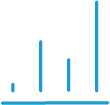PZU’s share price
Equities and Bonds






PZU made its debut on the Warsaw Stock Exchange (WSE) on 12 May 2010. Since day one, it has been included in the following indices: WIG20, WIG, WIG30, WIG-Poland, WIGdiv, WIG20TR and MSCI Poland. Since 2012, the PZU stock has also been taken into account in the sustainable development RESPECT Index (confirmed on 18 December 2017).
Warsaw Stock Exchange indices
In 2017, Poland’s key WIG20 index evolved within the range of 1,957-2,552 points (in 2016: 1,674-1,999 points), wrapping up the last session of the year at a level close to the annual high of 2,461 points (up by 26.4% y/y, or with a rate of growth almost six times greater than that in 2016).
In H1 2017, all major WSE indices were on the rise. In the second half of the year, this trend was maintained only by large companies. WIG20 increased by 7.0%, while sWIG80 declined by 9.2%. This, however, did not prevent the WIG index from reaching 67.8 thousand points, a record high, on a par with the level last recorded in 2007. Eventually, WIG ended 2017 at 63.7 thousand points, having improved by 23.2% y/y. The year 2017 was the best one for the Warsaw Stock Exchange since 2012.
PZU’s share price
In 2017, PZU’s shares remained among the most liquid companies traded on the WSE. With the market capitalization of over PLN 36.4 billion as at the end of 2017, PZU was the fourth largest Polish company listed on the Warsaw Stock Exchange in terms of capitalization, having ranked two places higher than at yearend 2016. PZU’s share in the total WSE trade value was 8.0% (ranking 4th).
The maximum price per share of PZU stock in 2017 was PLN 49.06 (at closing prices). The annual price trough of PLN 32.82 was recorded on 5 January 2017.
After adjusting the PZU share price by the disbursed dividends (in accordance with the methodology described on http:// stooq.pl/pomoc/?q=9&s=pzu), the price per share of PZU stock in 2017 repeatedly marked new highs, having peaked at PLN 47.72 and thus having beaten the historic record of 2014 by over 13%.
At the beginning of 2017, PZU’s share price continued the strong upward trend it embarked on in Q4 2016, having increased by 36.2% q/q, which was much higher than the q/q increases in WIG20 and WIG of 13.9% and 9.9%, respectively. In Q1 2017, the upward trend continued on both PZU and the market’s major indices. In Q2 2017, the PZU stock price again performed much better than WIG20, having grown 34.3% since the beginning of the year, compared to 18.1% growth of the WIG20 index. This situation persisted for most of the second half of the year. It was not until Q4 2017 that PZU’s shares began to slide towards the main market index. As a result, the rates of growth in WIG20 and PZU’s share price (ex-dividends) were similar and stood at approx. 27%.
PZU’s min/max share price at session closing from May 2010 to 2017

Source: www.gpwinfostrefa.pl
PZU’s share price adjusted for dividends paid from May 2010 to 2017*

PZU’s stock performance compared to WIG i WIG20

Source: www.gpwinfostrefa.pl
In 2017, PZU’s stock maintained very high liquidity. The average daily spread on PZU’s shares was a mere 7 bps (the lowest on the whole market). PZU’s stock accounted for 8.0% of the total market’s trading volume in PLN having exceeded PLN 18.9 billion.
The largest daily turnover (of 7.7 million shares) was recorded on the falling (-4.5%) trading session of 23 March 2017. The reason behind this emotional market behavior was the unexpected dismissal of the then CEO Michał Krupiński. Afterwards, in less than two weeks, the PZU stock price returned to its pre-23 March level. A further improvement in investor sentiment came as a result of the appointment of Paweł Surówka to the position of CEO of PZU SA on 13 April 2017. The decision was met with approval by the market, as the PZU stock price expansion attested on heavy trading. The share price increased by nearly 20% in just two weeks, outperforming the WIG and WIG20 indices hands down. In this period, the trading volumes reached 5 million shares per day, which was almost three times more than the daily average. Investors were especially fond of the new CEO’s public statements on the continuation of the Company’s strategy, including its dividend policy. Later in the year, the better performance of PZU’s shares vis-à-vis WIG20 was backed by the improving bottom line, in its insurance and investment business alike.
The largest single-session increase in the PZU stock price (+ 4.7%) was recorded on 19 May 2017, that is two days after the publication of the Company’s very good financials for Q1 2017.
The stock exchange session of 7 June 2017, when PZU and PFR announced the finalization of the deal to acquire a 32.8% equity stake in Bank Pekao for a total amount of PLN 10.6 billion, proceeded without any turbulence. On 8 December 2016, which was the date when PZU announced the acquisition deal, the PZU stock price increased 2.6% and the trade volume exceeded 10.5 million shares during the session.
In 2017, the value of OTC block trades on PZU shares increased to PLN 581.3 million (from PLN 123.7 million in 2016), which represented approx. 3.1% of the trade value in 2017.
Factors affecting PZU’s share price in 2017

Source: www.gpwinfostrefa.pl
Codes Quick Response (QR) for online transmission

Volatility
Compared to the broad WIG market, PZU’s systematic risk expressed by the beta coefficient (PZU stock price vis-à-vis the WIG index for daily shifts) in 2017 was 1.06 or 0.12 lower than the historic high recorded in 2016 (1.18). The annualized standard deviation for daily changes in the PZU stock price declined in 2017 by 5.5 percentage points y/y and stood at 23.6%. The value of this statistic for WIG and WIG20 fell by 3.8 p.p. and 3.9 p.p., respectively, to 11.8% and 15.1%.
PZU’s total shareholder return, calculated as the stock price difference plus the value of the distributed dividend, was 31.2% as at yearend 2017 (in 2015 and 2016, it was -23.8% and 3.7%, respectively). The dividend yield (calculated using the price per share of PLN 42.16 as at the end of 2017) was 3.3% (a dividend of PLN 1.40 share), which was 1.4 p.p. higher than the average of 1.9% for the WIG20 and WIG Banks indices.

| PZU’s stock-related statistics | 2017 | 2016 | 2015 | 2014 | 2013 |
| Maximum price (PLN) | 49,06 | 36,3 | 50,87 | 51,1 | 47,79 |
| Minimum price (PLN) | 32,82 | 24,38 | 31,43 | 40,9 | 38,5 |
| Closing price on the last trading session of the year (PLN) | 42,16 | 33,21 | 34,02 | 48,6 | 44,9 |
| Average session price (PLN) | 42,53 | 30,76 | 43,72 | 45,22 | 43,22 |
| Trading Volume (PLN m) | 18 902 | 16 755 | 20 145 | 18 401 | 19 970 |
| Average trading value per session (PLN m) | 75,6 | 66,8 | 80,3 | 73,9 | 80,9 |
| Number of transactions (units) | 985 515 | 1 046 398 | 835 471 | 621 224 | 585 205 |
| Average number of trades per session | 3 942 | 4 169 | 3 329 | 2 495 | 2 369 |
| Trading volume (units) | 448 832 864 | 558 496 833 | 470 048 842 | 407 247 220 | 464 899 980 |
| Average trading volume per session (shares) | 1 795 331 | 2 225 087 | 1 872 705 | 1 635 531 | 1 882 186 |
| Capitalization at the end of the period (PLN m) | 36 406 | 28 677 | 29 377 | 41 967 | 38 768 |
Ratios
As at the end of 2017, PZU’s shares had a high value of the P/ BV ratio of 2.49 i.e. twice the average for European insurance companies. According to analysts, this resulted from the high ROE, which at yearend 2017 was 21.1%.
| Capital market ratios for PZU’s shares* | 2017 | 2016 | 2015 | 2014 | 2013 |
| P/BV Market share price / book value per share | 2,49x | 2,21x | 2,27x | 3,19x | 2,95x |
| BVPS Book value per share | 16,93 | 15,05 | 14,97 | 15,25 | 15,20 |
| P/E Price/earnings per share | 12,51x | 14,73x | 12,54x | 14,14x | 11,77x |
| EPS (PLN)Equity holders’ net profit (loss) / number of shares | 3,37 | 2,24 | 2,71 | 3,44 | 3,82 |
* calculation using the PZU Group’s data (according to IFRS)
